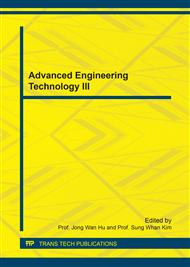[1]
U. Hasirci, A. Balikci, Z. Zabar, L. Birenbaum, A novel magnetic-levitation system: design, implementation, and nonlinear control. Plasm. Sci. 39(1) (2011) 492-497.
DOI: 10.1109/tps.2010.2053389
Google Scholar
[2]
D. Roy, D. Saruhashi, S. Yamada, M. Iwahara, Fabrication and development of a novel flux-concentration type linear induction motor. Magn. 36(1) (2000) 3555-3557.
DOI: 10.1109/20.908896
Google Scholar
[3]
C. L. Kuo, T. H. S. Li, N. R. Gue. Design of a novel fuzzy sliding-mode control for magnetic ball levitation system. J. Intell. Robot. Syst. 42 (2005) 295-316.
DOI: 10.1007/s10846-004-3026-3
Google Scholar
[4]
H. Kurobe, T. Sekine, H. Asai, Alternating direction explicit-latency insertion method (ADE-LIM) for the fast transient simulation of transmission lines. Pack. Manuf. Tech. 2 (2012) 783-792.
DOI: 10.1109/tcpmt.2012.2186137
Google Scholar
[5]
T. Sekine, H. Asai, Block-latency insertion method (Block-LIM) for fast transient simulation of tightly coupled transmission lines. Electromagn. Compatib. 53 (2011) 193-201.
DOI: 10.1109/temc.2010.2047108
Google Scholar
[6]
B. L. J. Gysen, J. J. H. Paulides, J. L. G. Janssen, E. A. Lomonova, Active Electromagnetic.
Google Scholar
[7]
P. Thomas. Manual for model 730: Magnetic Levitation System. USA: ECP, Educational Control Products. (1999).
Google Scholar
[8]
S. J. Joo, J. H. Seo, Design and analysis of the nonlinear feedback linearizing-control for an electromagnetic suspension system. Contr. Syst. Tech. 5(1) (1996) 135-144.
DOI: 10.1109/87.553672
Google Scholar
[9]
A. Rubaai, M. J. Castro-Sitiriche, DSP-based laboratory implementation of hybrid-fuzzy-PID controller using genetic optimization for high-performance motor drives. Ind. Appl. 44(6) (2008) 1977-(1986).
DOI: 10.1109/tia.2008.2006347
Google Scholar
[10]
P. Dehghanian, M. Fotuhi-Firuzabad, S. Bagheri-Shouraki, A. A. Razi Kazemi, Critical component identification in reliability centered asset management of power distribution systems via fuzzy AHP. Syst. 6(4) (2012) 593-602.
DOI: 10.1109/jsyst.2011.2177134
Google Scholar


